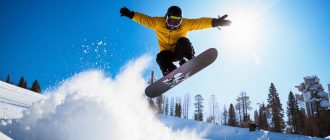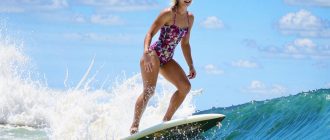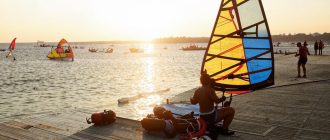SUP-surfing is becoming more and more popular every year: not only is it a fun way to spend time alone on the water, but it’s also a good way to exercise your whole body. How to start SUP-surfing, what equipment is needed and what is important to remember – we discussed with a professional athlete.
Victor Chadkin
sapsurfer, PRO-expert of Sportmaster PRO
Tells about the subtleties of sapsurfing.
How to choose a board and accessories
The first thing you’ll need is the SUP board itself. Of course, at first you shouldn’t buy it – it’s better to borrow it from a friend or rent it at the station where you plan to practice. If this kind of leisure activity fascinates you, you can think about buying your own board.
Stations have boards for different levels of training – for the first lessons, experts will help you choose the right board. When you decide to buy your own SUP board, you’ll have a wide range of boards to choose from – depending on your riding style, design, functionality and features.
As your first SUP board, we recommend you consider a wide (80 cm or more) and long (3 to 4 meters) inflatable board, which is the best option for beginners. It’s easy to transport, it will help you catch your balance and feel confident in the water.
And then you can decide which direction of SUP-surfing is closer to you and, accordingly, which board to choose – either stay on a wide inflatable board, or switch, for example, to a rigid board for higher speed and better maneuverability.
The second important piece of equipment is a SUP paddle. Visually it resembles an elongated drop-shaped canoe paddle – its shape is optimized for the most efficient paddling. Budget boards are often equipped with the simplest aluminum paddle. More expensive and advanced models don’t come with a paddle at all, as professionals usually pick it up themselves.
There are no special requirements for SUP-paddle: it should be of suitable length (about 20 cm above the height of the athlete), as the material can be the same aluminum. There are also more advanced paddles made of carbon – strong and lightweight – but they cost considerably more than aluminum ones.
Another important element of equipment is a lich. This is a cable that is attached to the athlete’s leg at one end and to the board at the other. It is needed to prevent the board from being carried away by the current. The rope can be included with the board, but there are boards without it – be sure to pay attention to this when buying and buy insurance if necessary.

The choice should be made depending on the body of water where the lesson takes place. For waves it is better to choose a straight lich, which will keep you at a distance from the board when falling. And for shallow bodies of water on calm water it is better to buy a twisted, which will not cling to snags and other obstacles under water.
To properly select a SUP-board and related equipment, it is better to contact specialized stores, where experts will help you with the equipment, based on your physical and sports data.
What else you need to know
At the first lessons you must have a life jacket – in addition to the voice of reason, this is required by law, because SUP-board is considered a watercraft.
Another safety requirement is a whistle: you should always be able to warn other paddlers of danger. If you plan to sail far from the shore, it is better to take your cell phone with you in a special hydro case.
Clothing should be selected according to the season. For the hot season and warm water suitable swimsuits or shorts and hydro-shirts, not constraining movements. And for cold weather you will definitely need a wetsuit, which will help to avoid hypothermia.
The body should be reliably protected from the sun: in the water you tan much more intensively, so even variable cloudiness can cause sunburn, and even sunstroke. Headgear, sunglasses, creams – you’ll need all of these for sapsurfing in hot weather.

What about the training itself
It’s impossible to describe the whole process and riding technique in one article – you need a coach to teach you how to paddle and turn correctly. We’ll give you some basic tips on putting your body on the board and keeping your balance.
You should enter the water with your SUP board up to knee level. The fins of the board should not touch the bottom. Holding the edges of the board, put both knees on it and gradually move your feet to the center of the board (keep holding the edges with your hands). Stand up gradually, without jerking: first lift your chest, then straighten your knees and stand up to your full height.
To keep your balance, keep your feet parallel. Equal distance from the center of the board (where the carry handle is). Don’t confuse the front and back: your toes should be facing the nose of the board. Watch your body position: bend your legs slightly and lean your body slightly forward. Also, look down less – to keep your balance, it is better to look forward at the water and the horizon.

The front of the paddle should always face the nose of the board. If you have it on the right, then your left hand should be on the T-handle of the paddle and your right hand should be holding the middle of the shaft (paddle). If it is on your left, the described hand position should be mirrored.
Try to fall into the water, not on the board, so the risk of injury will be lower. A beginner cannot do without falling in the first time. When falling, do not let the paddle out of your hands, and if it does happen, first climb on the board, then paddle to the paddle. To get on the board, you need to put your hands on the middle of the board, pull yourself up and forward with your whole body, lie on the board with your stomach and alternately throw your legs – then kneel down and calmly get up.
Sapsurfing is a fun and fairly safe form of exercise. It is both good cardio and muscle training. Besides, sapsurfing can be done at any time of the year when the water is not covered with ice – if you are well prepared for the lessons, everything will go smoothly and hopefully dry.
If you enjoy outdoor activities by the water, this article will show you what else you can do.






